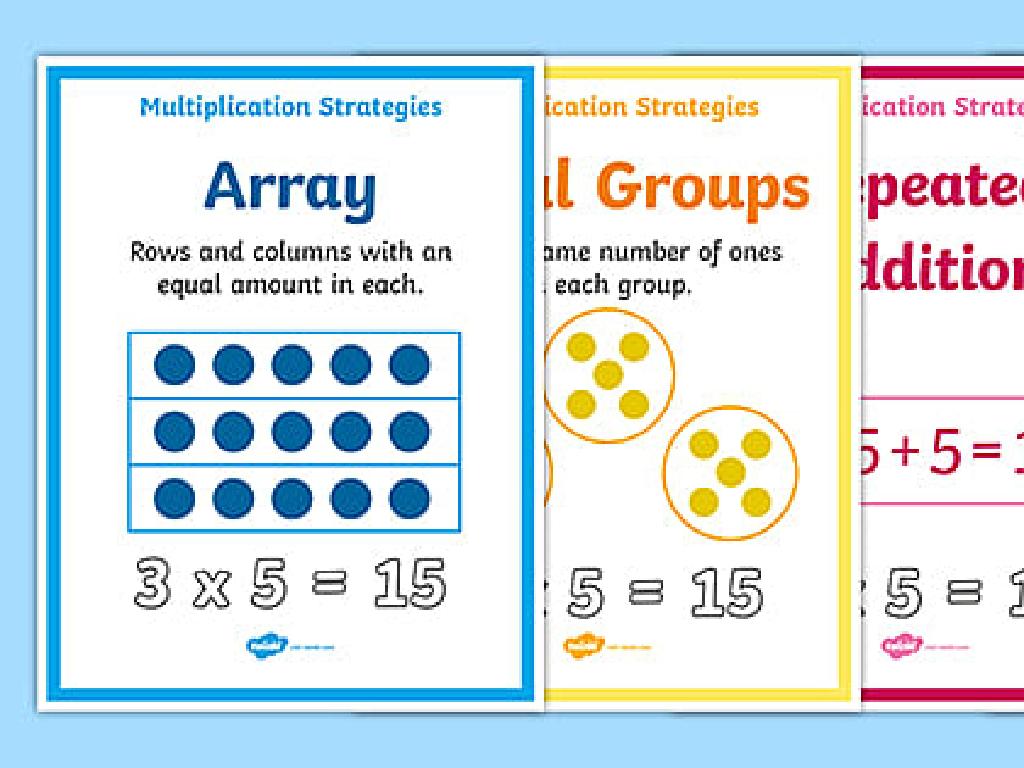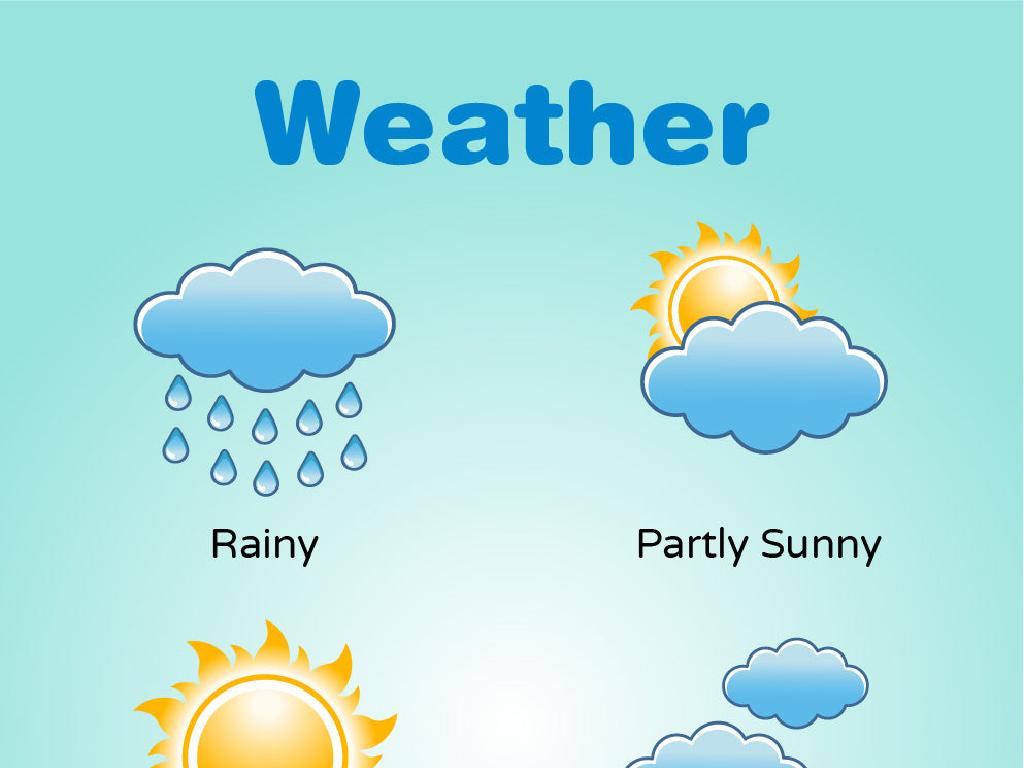Evaluate Multiple Design Solutions To Prevent Flooding
Subject: Science
Grade: Fifth grade
Topic: Engineering Practices
Please LOG IN to download the presentation. Access is available to registered users only.
View More Content
Engineering Against Floods
– Explore flood prevention
– How can we stop floods from damaging areas?
– Understand flooding impacts
– Floods can destroy homes and landscapes.
– Define engineering
– Engineering is solving problems using science and math.
– Engineering in flood control
– Engineers design barriers and drainage to manage floods.
|
This slide introduces the concept of engineering as it relates to solving real-world problems, specifically the challenge of flooding. Begin by discussing the devastating effects of floods and the importance of finding solutions to prevent them. Explain that engineering is the application of scientific and mathematical principles to design and build structures and systems. Highlight how engineers play a crucial role in creating flood defenses, such as levees, dams, and sophisticated drainage systems, to protect communities. Encourage students to think like engineers and consider what solutions they could come up with to help prevent flooding in their own neighborhoods.
Understanding Flooding: Causes and Impacts
– Natural causes of floods
– Weather events like heavy rain, hurricanes, and melting snow
– Human contributions to flooding
– Deforestation, poor land management, and urban development
– Flood impact on communities
– Damage to homes, loss of crops, and disruption to wildlife
– Evaluating flood prevention
|
This slide aims to educate students on the various causes of flooding, both natural and human-induced, and the significant effects floods can have on communities and the environment. Discuss natural causes such as severe weather conditions and the role of human activities like deforestation in exacerbating flood risks. Highlight the consequences of flooding, including property damage, economic loss, and ecological disruption. Encourage students to think critically about how engineering practices can help mitigate these risks and protect communities. This discussion sets the stage for exploring different engineering solutions to prevent flooding.
Evaluating Flood Prevention Designs
– Understanding design solutions
– A design solution solves a problem through planning and construction.
– Examples of anti-flooding measures
– Dams, levees, and flood barriers are some ways to prevent flooding.
– Criteria for choosing solutions
– Engineers consider cost, impact, and effectiveness to select the best option.
– Importance of effective design
– The right design can save homes and habitats from flood damage.
|
This slide introduces students to the concept of design solutions in the context of engineering practices to prevent flooding. Begin by explaining what a design solution is and how it applies to real-world problems like flooding. Provide tangible examples such as dams, levees, and flood barriers to illustrate how these solutions work. Discuss the factors engineers must consider when choosing the most appropriate solution, including cost, environmental impact, and effectiveness. Emphasize the importance of selecting effective designs to protect communities and ecosystems from the adverse effects of flooding. Encourage students to think critically about the solutions and how they might be applied in their local area.
Case Study: Flood Barriers
– Understanding flood barriers
– Barriers prevent water from entering areas.
– Pros and cons of barriers
– Barriers can save homes but might be costly.
– Real-world barrier examples
– Netherlands’ Delta Works or New Orleans’ levees.
– Evaluating barrier effectiveness
|
This slide introduces students to the concept of flood barriers as a design solution to prevent flooding. Begin by explaining how flood barriers are structures designed to block or redirect the flow of water to protect areas from flooding. Discuss the advantages, such as protection of homes and prevention of water damage, and the disadvantages, including the potential high cost and environmental impact. Provide real-world examples like the Delta Works in the Netherlands and the levee systems in New Orleans to illustrate the application of flood barriers. Encourage students to think critically about the effectiveness of these solutions and how they can be evaluated in terms of cost, environmental impact, and long-term sustainability.
Case Study: Elevated Structures
– Elevating buildings against floods
– Raising a building’s foundation above flood levels.
– Pros and cons of elevation
– Advantages: Reduces damage, may lower insurance. Disadvantages: Can be costly, accessibility issues.
– Real-world elevated structures
– Examples: Stilt houses in flood-prone areas, coastal homes on pilings.
|
This slide introduces students to the concept of elevated structures as a design solution to prevent flood damage. Start by explaining how elevating the foundation of buildings can keep them above potential floodwaters. Discuss the advantages, such as reduced risk of flood damage and potentially lower flood insurance premiums, and the disadvantages, including higher construction costs and possible accessibility concerns for individuals with disabilities. Provide real-world examples, like stilt houses in areas that frequently experience flooding or homes built on pilings in coastal regions. Encourage students to think critically about these solutions and how they might be applied in their own communities.
Green Infrastructure: Nature’s Role in Flood Prevention
– Understanding Green Infrastructure
– Using plants and soil to manage rainwater
– Pros and Cons of Green Solutions
– Benefits: eco-friendly, sustainable. Drawbacks: maintenance, space
– Real-World Green Infrastructure
– Examples: rain gardens, green roofs, permeable pavements
– Evaluating Green Infrastructure
|
This slide introduces students to the concept of green infrastructure as a method to prevent flooding by utilizing natural processes. Discuss how plants, soil, and other natural elements can absorb and manage rainwater, reducing runoff and the risk of floods. Highlight the advantages of green infrastructure, such as its environmental benefits and sustainability, while also addressing potential disadvantages like the need for regular maintenance and space requirements. Provide real-world examples such as rain gardens, which absorb stormwater runoff; green roofs, which can reduce the amount of water reaching the ground; and permeable pavements, which allow water to seep through and reduce runoff. Encourage students to think critically about how these solutions can be evaluated and what factors might influence their effectiveness in different scenarios.
Evaluating Flood Prevention Designs
– Criteria for evaluating solutions
– How to judge a good design? Think about safety, durability, and how easy it is to build.
– Consider cost, effectiveness, impact
– What’s affordable? What works best? What’s safe for our planet?
– Group discussion on best solutions
– Share thoughts with classmates and decide which design you think is the best.
– Decision-making in engineering
– Engineers must decide the best option by comparing different solutions.
|
In this slide, students will learn how to evaluate different design solutions to prevent flooding, considering various criteria such as cost, effectiveness, and environmental impact. They will engage in a group discussion to apply these criteria and debate which solution might be the most appropriate for a given scenario. This exercise will help them understand the decision-making process in engineering and the importance of considering multiple factors when evaluating potential solutions. The teacher should facilitate the discussion, ensuring that each student contributes and considers the trade-offs between different design choices.
Class Activity: Flood Prevention Engineering
– Identify potential flood problems
– Brainstorm various solutions
– Think of ways to stop water from entering homes or streets
– Select the best solution idea
– Consider effectiveness, cost, and environmental impact
– Draw and present your design
– Use diagrams to explain how your design works
|
This activity encourages students to engage in the engineering design process to address the real-world problem of flooding. Students should start by identifying where and why flooding might occur. Next, they should brainstorm different ways to prevent or mitigate flooding, considering factors like cost, environmental impact, and practicality. After selecting their best idea, they should draw a detailed diagram of their flood prevention design. Finally, they will present their solution to the class, explaining how it works and why they believe it’s effective. For the teacher: Prepare to offer guidance on the brainstorming process and provide feedback on their designs. Possible activities include designing a levee, a rain garden, or a system of water barriers.
Flood Prevention: Conclusion and Reflection
– Recap flood prevention methods
– Discuss importance of prevention
– Flooding can damage homes and the environment.
– Reflect on what we’ve learned
– Think about the best solutions and why they work.
– Engage in class discussion
– Share your thoughts on today’s lesson.
|
This slide aims to wrap up the lesson on flood prevention by summarizing the various solutions discussed, such as levees, floodwalls, and green infrastructure. Emphasize the significance of preventing floods to protect communities and ecosystems. Encourage students to reflect on the information presented and to consider which solutions they think are most effective. Facilitate a class discussion, allowing students to share what they’ve learned and to voice any questions or ideas they may have. This will help reinforce their understanding and give them a sense of involvement in the topic.






